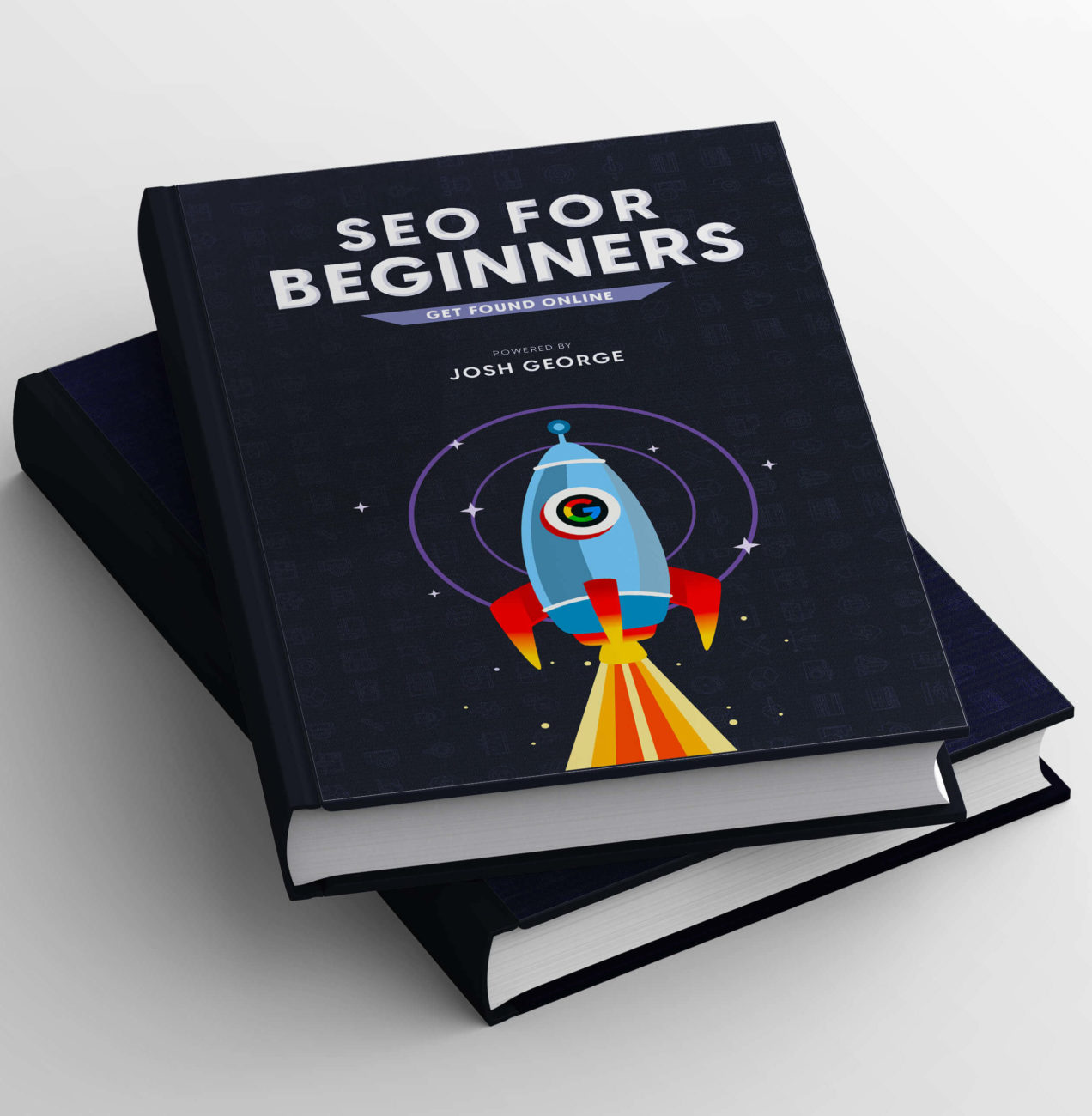SEO and organic traffic are the top priorities of 61% of the marketers in a 2022 marketing trends report. The reason for this preference is simple. SEO brings customers to you as opposed to reaching out to them. Who wouldn’t want that? So if you are wondering how to build SEO strategy that works for you, you are at the right place.
This read breaks down some steps you can take to curate an SEO strategy that caters to you and your audience.
Moreover, SEO is often misunderstood as an initiative for the benefit of Google’s spiders. We will show you how this isn’t true and how your audience must be at the crux of your SEO, website, and content decisions.
A famous author and social media expert, Wendy Piersall, once said, “Google only loves you when everyone else loves you first.”
We couldn’t agree more. Your content must align with the target audience and their needs. Once you get this right and customers love you, Google will love you too.
From there on, you will only need a little bit of additional help in optimizing search engine algorithms.
With this concept at the forefront, let’s understand SEO strategy and how you can create it too.
What is an SEO Strategy?
SEO strategy is a cumulative plan for your website and content to enhance your search engine rankings. These strategies ensure that you get a more significant market share in organic traffic – because increased organic traffic translates to better business.
However, it is also essential to remember that you need quality traffic to retain your ranking. You can make this happen by making your website follow the best SEO practices and providing the information your users are seeking when they arrive at your web page.
How Does SEO Help Your Business?
We’ve established that SEO is important for organic traffic. But how exactly does it happen and help you? Let’s understand this before you create an SEO strategy.
Here are some numbers that represent the benefits of an SEO done well.
1. The click-through rate (CTR) for ranking in the first position in Google’s search results is 34.2%. This number drops to 17.1% and 11.4% in the second and third positions, respectively.
It is clear that the higher you rank for search queries, the better your chances are of directing users to your website.
As you can tell, there is a significant drop between the first and third positions alone. So you can imagine what would happen if your content is hidden on the second page and beyond – your target audience will never find you.
2. When it comes to customer acquisition, SEO can decrease the cost by 87.41% compared to digital advertising.
Digital advertising has its role in marketing. It is undoubtedly beneficial to your business in many ways.
But wouldn’t you like to see what you could achieve organically first? By optimizing your content for the users and making sure Google finds it, you can acquire customers on the fly.
3. Organic search gives B2B organizations 2X more revenue when compared to other avenues.
If you are a B2B company, you must have a lot of different channels to boost your revenue streams. Some may be social media, advertisements, events, and much more.
But one way that can give you consistent ROI and increase revenue is showing up on relevant search results. This is where SEO helps you.
Now that you know a little more about the intention behind building an SEO strategy, let’s get started on the appropriate steps and actions you can take.
An Overview of How to Build SEO Strategy
SEO strategy isn’t just about learning best practices and implementing them.
You need to devise a plan instead of following tactics. We have an overview of the things you need to do to achieve your SEO strategy, along with the parallel actions you can take as well.
Furthermore, you get a comprehensive pathway to navigate SEO when you bring these actions into a plan.
Let’s dive in!
Understand Your Existing Website
Before establishing an overarching strategy for search engine optimization, understand your website well. Once you find out your website’s strengths and weaknesses, you can divulge your focus on creating a strategy with a direction.
Therefore, keyword research isn’t the first step toward SEO, contrary to popular opinion. Understanding your website’s current SEO performance is the first step.
You can use the free or paid versions of the SEO tools such as Google Analytics, SEMrush, Ahrefs, Moz Pro, and many others available in the market today.
Leveraging these tools, you can find out information about:
1. Amount of existing traffic
2. Unique visitors
3. Pages that are ranking for some keywords
4. Pages that are not performing well
5. The navigational path through which visitors came to your site
6. The bounce rate of your site and web pages
7. Site speed
8. Audience report
9. And so much more!
The free version of a tool like Google Analytics will be a stepping stone to understanding your website well. You need to create an account, add your website, and add the necessary tracking details to your site to start using it. You can delve as deeply as you want to learn about your site.
Formulate Goals for Your Business
Once you learn how your website is currently performing, the next essential step is formulating your goals.
These goals are solely dependent on your business and vision for the brand. Here are six questions you need to answer.
1. Which product or service do you want to focus your efforts on?
2. How many users are you aiming to reach?
3. Which geographies do you want to focus on, and what is the demography of the visitors?
4. Are you looking to obtain more organic traffic? If yes, what is your target?
5. What are your revenue targets?
6. What kind of keywords do you primarily want to associate with your brand?
This is the starting point in your SEO strategy. Additionally, this step is essential because you cannot possibly have an SEO strategy to rank for all the relevant keywords and hope for the best without an actual goal.
With a goal, you can devise plans that align accordingly and then optimize your website.
Define the KPIs for Your SEO Strategy
Ideally, every website would love SEO efforts to always show results by showing up in the top 3 positions of the search engine result pages (SERPs). However, that cannot always happen. At least not for every web page and content that you produce.
Thus, it is essential to define how you will track the success of your SEO strategies before executing them.
As you can see in the graph below, according to a study, most marketers define the success of their SEO strategy differently. Among them, keyword rankings are the most sought-after. Organic traffic, time spent on a page, and others are important too.
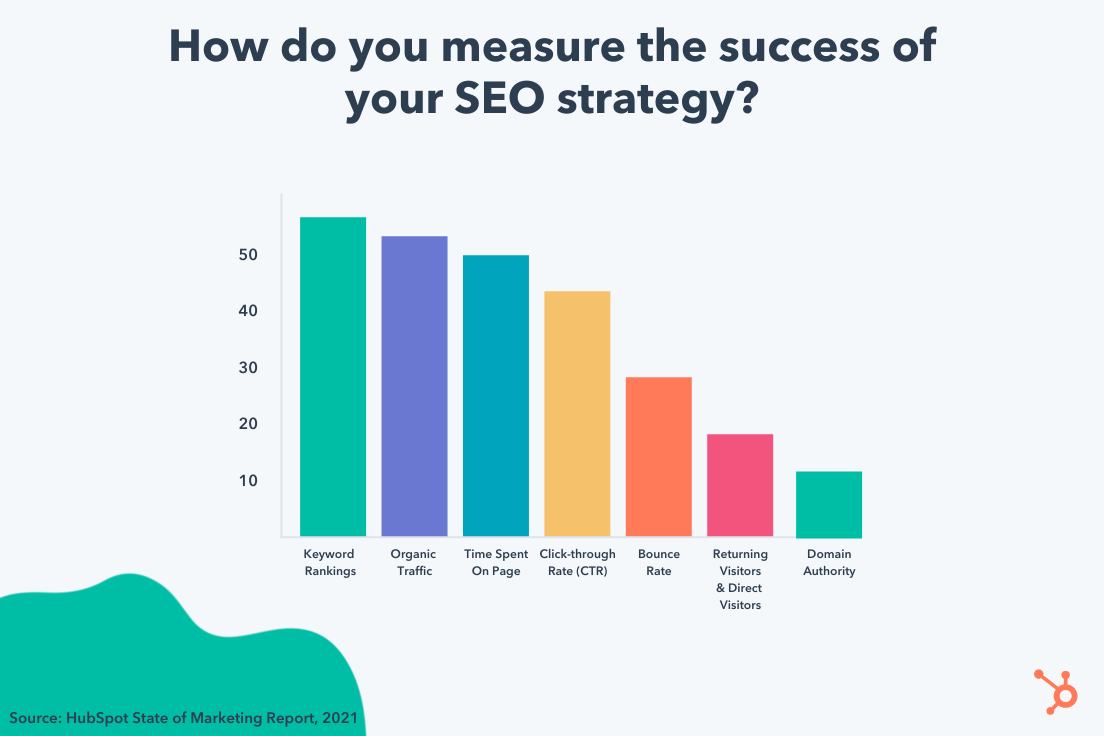
Likewise, your KPIs for SEO success don’t have to be the same. It can ultimately depend on your brand and what your expectations are.
Here are some of the KPIs you can consider:
1. Organic Visibility: You can use tools like Google Analytics to track how many impressions you received on search engines. Higher visibility means Google thinks your content fits the search queries.
2. Rate of Conversions – You can measure how much your organic traffic converted to sales and aided in revenue.
3. Duration of Organic Sessions: You can view how long visitors stay on your website using Google Search Console. If they are staying a considerable amount of time, based on the page’s content, you are heading in the right direction.
4. Number of Backlinks: Backlinks are links pointing to your website from other sites. When you create informative content or have valuable graphics, other websites will start referring to you on their content resources.
5. Content Efficiency: You can understand how well your content resources are doing and if they are meeting their goals regularly. You have to create each content piece with an objective and ensure they are met.
6. Keyword Rankings: These will tell you how well you meet what the users are looking for. When you create content for the users, and they like it, you will rank well for keywords.
These are some of the ways you can measure your SEO strategies. Now that you know how to set goals and define the KPIs, the work begins.
Take the Eight Steps to Meet Your SEO Goals
In 2020, people spent a whopping $79 billion on SEO and its services. There is a reason marketers are eager to spend on SEO and experience the results – they work.
Furthermore, capitalizing on search rankings can make a difference to your business. So here are 8 steps that will help you reach your SEO goals.
-
Conduct Keyword Research and Understand the Search Intent
Keywords are crucial for a solid SEO strategy. However, you have to create an efficient keyword strategy and not blindly follow the bulk of keywords relevant to your website.
You have to target keywords that align with your goals and the content you are creating. Most importantly, they have to be keywords your customers are typing on search engines.
You can easily use tools such as UberSuggest, Ahrefs, SEMrush, and more to understand the keywords used in your industry.
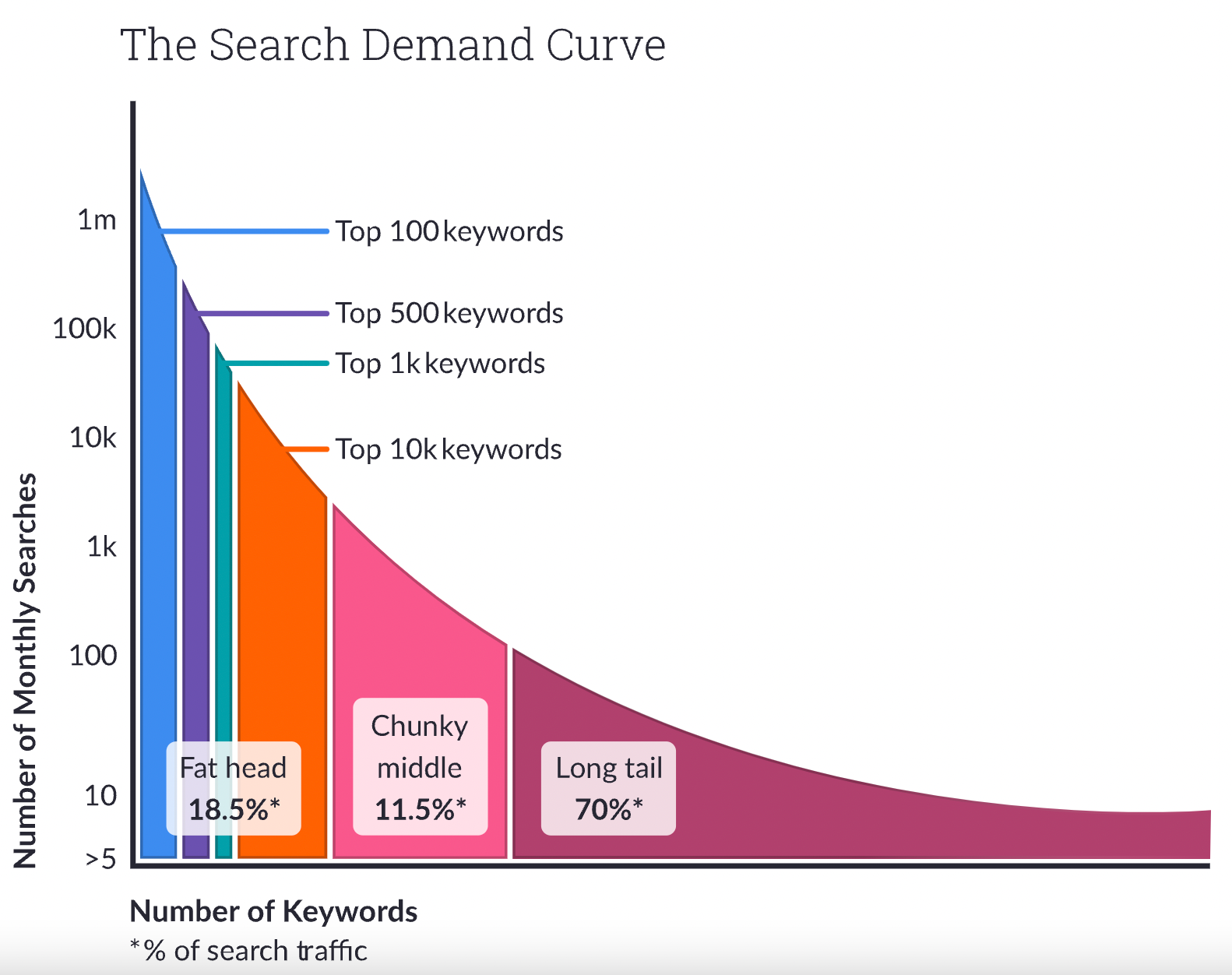
As you can see in the image above, there are different types of keywords with different search volumes. Here the “fat head” keywords receive the highest search volume. However, it is interesting to note that most keywords are in the “chunky middle” and “long tail” sections. Let’s learn a little about them.
Popular Keywords
These are the “fat head” keywords. While they have the most demand, they also have the highest competition. Additionally, they can also lack context. For example, if you’re selling sweaters in the US and trying to rank for the apparent term “sweaters,” you are in for a fight and disappointment.
Someone who types in just that one word could probably be searching for inspiration to stitch their sweater, want to look at what is available online or are simply browsing. If you rank for this, you will have difficulty converting such users into customers.
Long-Tail Keywords
These keywords are much more specific and can lead users right to you. They are usually 3-5 words long.
For example, they can be “red sweaters for winter near me.”
If you integrate this into your website and create content around it, customers will find you when someone looks for this query. Considering the nature of the query, they are ready to make a purchase. So focusing on long-tail keywords will bring more niche to your keyword strategy.
Latent Semantic Keywords
Search engines are intelligent today and no longer expect you to use repeated words to prove a point. This would be keyword stuffing, and you will be flagged for such practices.
LSI or Latent Semantic keywords are words that are related to your primary keyword. For example, if your main keyword is garden, then terms like a garden store, flower shop, florist, and lilies could all be treated as related to it.
When you use such semantic keywords, you increase your range of ranking possibilities.
Understand User Intent
A crucial aspect of keyword research is understanding the user’s search intent. This directly relates to creating quality content.
If you are wondering how to understand this for your keywords, use Google.
Google the keyword you are trying to rank for and look at the search results. The top results essentially satisfy the user’s intent with the search query.
For example, you create a product page for a pet care keyword. However, most of the results are directed toward health management. Thus, when a user comes across your product and finds that it is of no use to them at the moment, they will quickly navigate away from your page.
This is detrimental to your ranking as Google will now assume you are no longer fulfilling the keyword’s purpose. That’s why understand the user’s perspective and intention as you create content.
-
Research Your Competitors Well
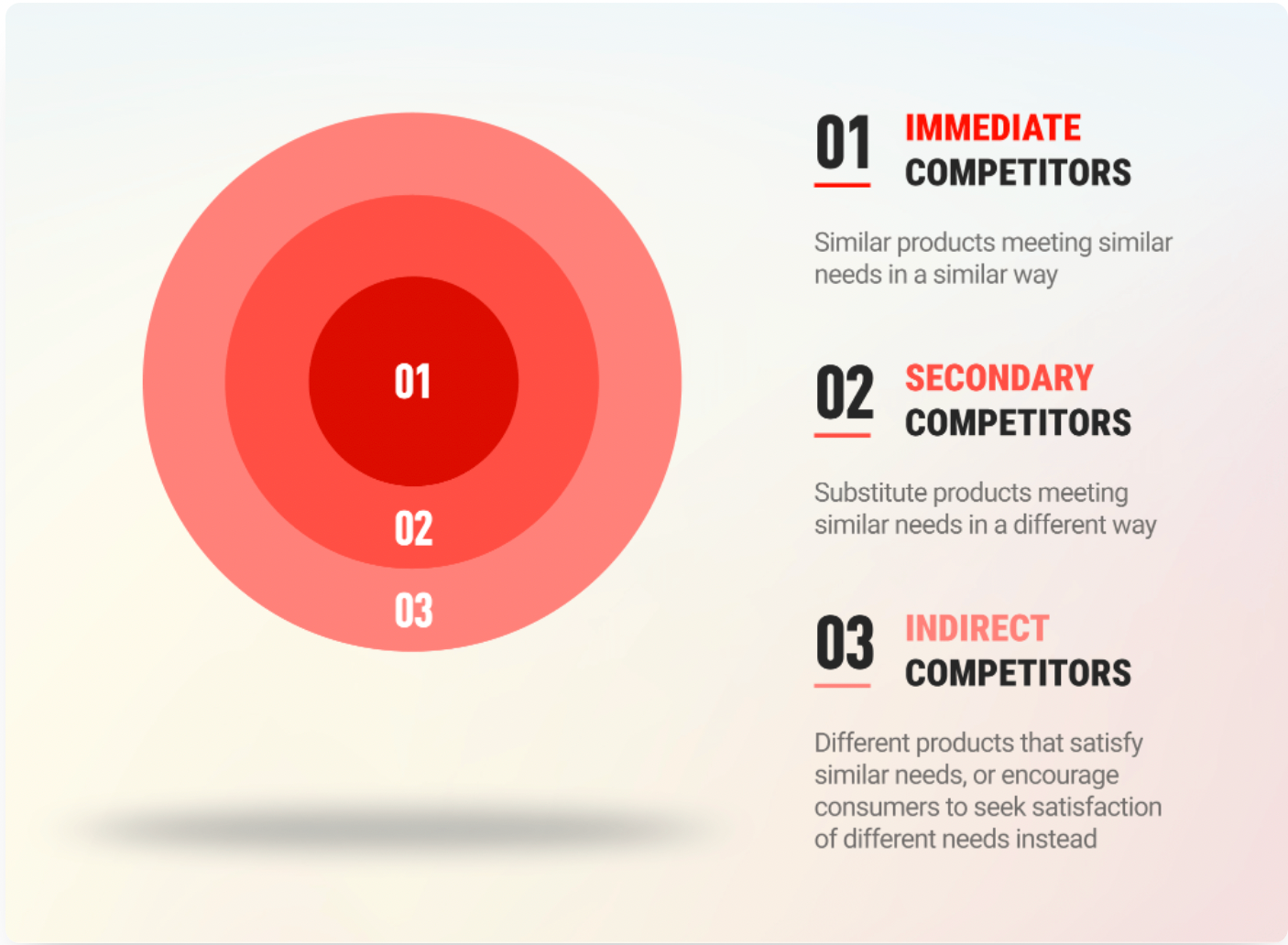
Whichever industry you are from, you are bound to have competitors. Thus, heed what your competitors are doing in creating your SEO strategy.
If they are ranking better than you right now, they might be doing something right.
Using SEO tools, you can study their organic traffic, keywords they are ranking for, how they build links for a backlink profile, page speed, and more.
Learn what they are doing right when they appear further up in the search rankings. You can create content that addresses similar topics or use your brand’s strengths to create different content.
Likewise, as you can see in the image above, immediate competitors need to be at the core of an effective SEO strategy. However, you cannot ignore secondary and indirect competitors.
For example, another coffee company becomes your direct competitor if you are a coffee brand. But, a Tea brand also caters to a similar audience, if not the same. They are your secondary competitors. Take it a notch higher, and any company that provides drinks to your customers is your indirect competitor.
You can track their SEO strategies and learn a lot about how to reach your customers.
-
Create a Content Strategy
Now that you understand keywords, you have to put them into practice with an SEO content strategy. This strategy will define what kind of content you want to create and how to meet your SEO goals through them.
This, however, is a nuanced approach. Using keywords and creating content is not enough. You have to plan content for a keyword along with its related keywords.
You can fulfill this approach by focusing on the main topic for a blog post and assigning topic clusters for each of these topics.

The above image represents an example of a primary topic, also called a pillar page, along with topics using related keywords.
Here “home remodeling” is used as the pillar page. It is a vast topic and could have several parallel stories drawn from it. Therefore, topics like home remodeling estimates, ideas, and inspiration are all content ideas that you can link to the pillar page.
By doing this, you are providing opportunities for internal linking. Diversify your content marketing this way, and your content will get Google’s attention.
-
Optimize On-Page SEO and Technical SEO
The way you create content is essential to search engine traffic. However, your SEO plan will be incomplete without getting into the nitty gritty details of your website.
As you maintain your site, pay attention to on-page SEO by learning how you write meta descriptions, title tags, headers ranging from h1 to h6, images used, and the overall user experience.

As you can see above, web pages without meta descriptions which are small descriptive sentences about the topic on the web page, receive less CTR, especially if you want to rank in the top positions on the first page.
Additionally, you must be mindful of the keywords relevant to the web page during on-page optimization, writing a meta description, adding the title tag, or defining the headers.
Technical SEO
This refers to the optimizations to the backend of your website and servers. Technical SEO is responsible for how your website is crawled by the search engine bots and how your content is perceived.
For a comprehensive SEO strategy, you have to ensure an expert takes care of this aspect of your website.
-
Create a Mobile Search Strategy
Here is a snapshot of the mobile-friendly update by Google. It clearly defines how having a mobile site that is easy to navigate and use will be preferred over companies that only have an optimized desktop site.
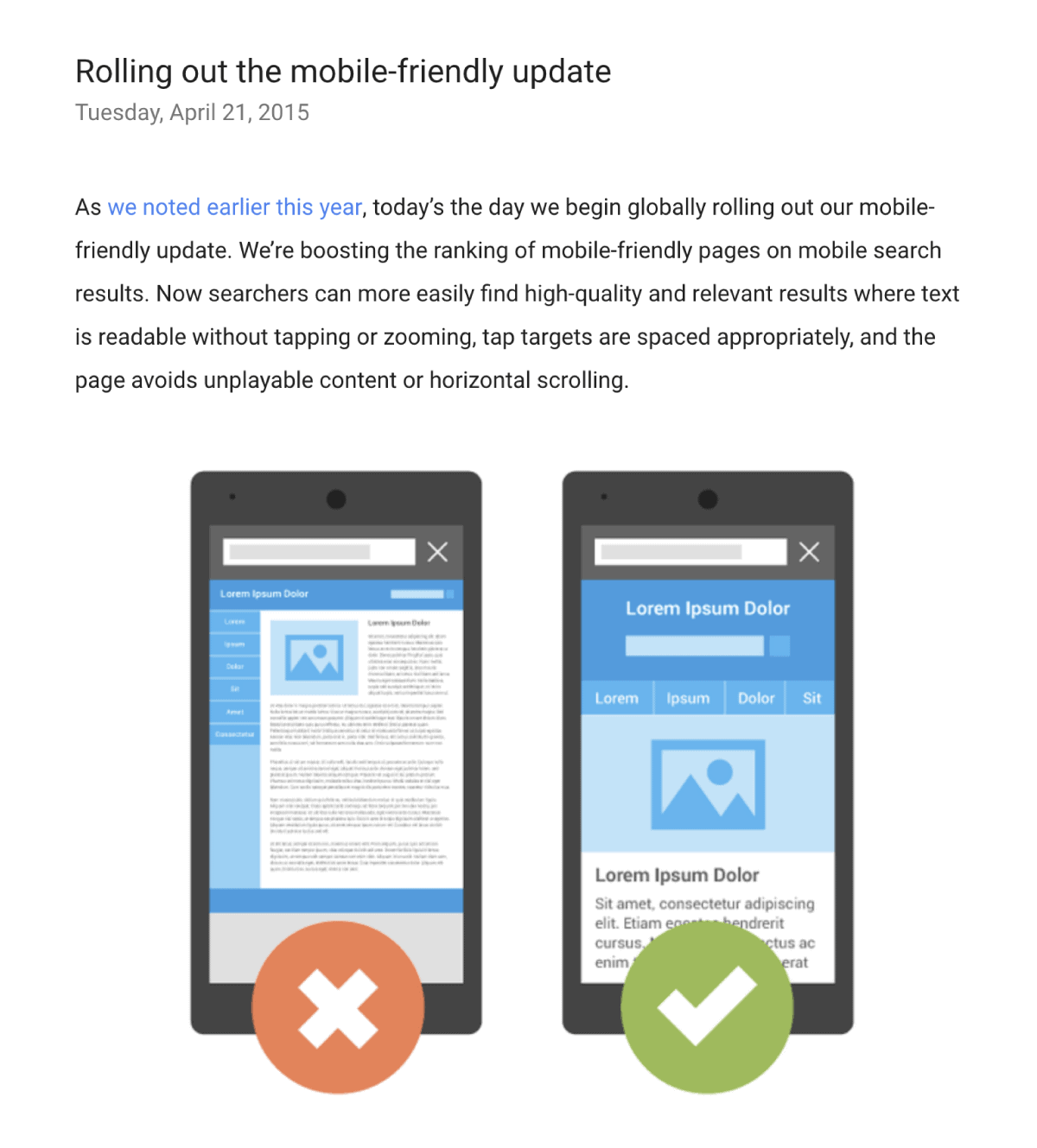
Google’s mobile-first index update makes it imperative for you to focus on mobile SEO. This includes easy-to-navigate options, fonts that are easy to read on a mobile, and a high mobile speed. You can use Google’s mobile-friendly test tool to check if your website is doing well in this area.
-
Optimize for Off-Page SEO
Off-page SEO refers to actions you can take to ensure others talk about you. These can be online reviews, backlinks from quality websites, and social media mentions.
Off-page SEO is important because search engines and users will trust you more when others talk positively about you on the internet. It’s like when you take a recommendation from a friend instead of a random advertisement on where to shop.
Furthermore, a link-building strategy is among the main concepts to have a good off-page SEO. You can receive natural links when you produce good content and when others quote you. But reaching out to high-quality websites relevant to your brand for guest blogging, fixing broken links, and adding value to their web pages will significantly enhance your backlink profile.
You might be even more intrigued to know that Google’s top results have 3.8 times more backlinks than those in lower positions. So if you want to rank higher, you need to ace off-page SEO.
-
Create a Voice Search Engine Optimization Strategy
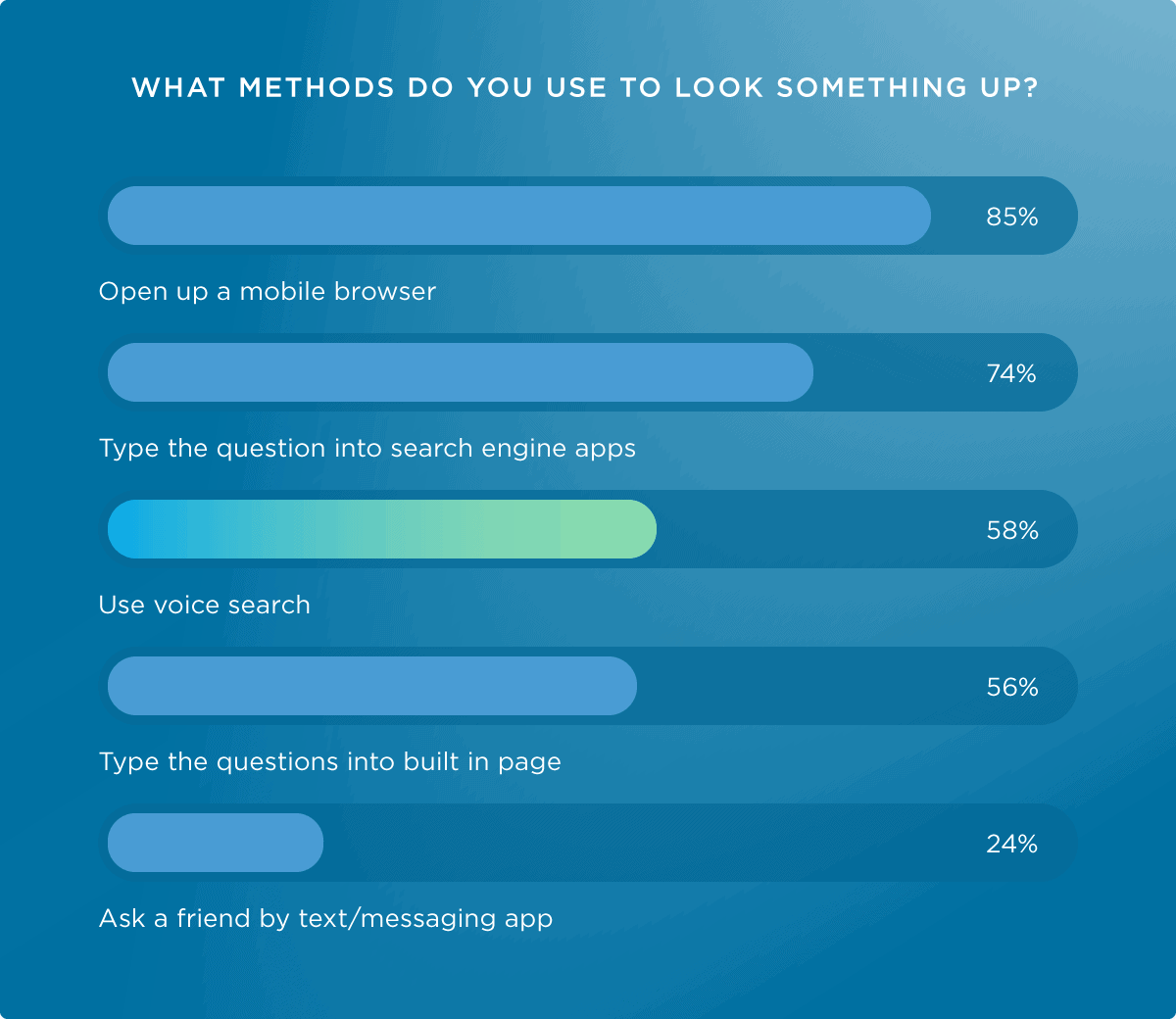
When you see the image above, you will realize that voice search is growing in demand. 58% of users prefer voice search. Therefore you should be paying attention to this feature.
Voice search demand is only rising. There are several reasons for it, mainly because mobile devices are becoming more tech savvy and making it incredibly easy to look something up using voice commands.
Additionally, since voice search is growing, you can also lean on long-tail keywords and questions in your content to align with their queries. Since speaking the search term is much easier, people will be more specific and expect specific results.
-
Update Your Local SEO
Local listings are not limited to users who have a physical store. From an SEO standpoint, it helps you claim your Google my Business profile and lets you build this page for new visitors.
You can use local SEO to your advantage, ask customers to write feedback when they are satisfied with your services, and fill the listing with correct details.
Additionally, if you own a physical store, you’ll be happy to know that when people look up something, 76% of them will visit the store as well. So if you show up on local search results and your business page on Google has good reviews, you will probably make a sale that day without even reaching out to them!
You Can Now Start Working on Your SEO Strategy!
If you started this blog with a question on how to build SEO strategy, you now have all the answers to transform your business with a winning SEO strategy.
Additionally, as you follow through with the steps above, you can regularly track the progress of your strategy using an SEO tool and create informative SEO reports.
Remember to consistently understand how search engines update while monitoring and enhancing your website. But as you follow SEO best practices, never forget that your content and research are for the user and that seeing results the right way can take time. The methods, tactics, and tricks can be updated over time, but the user experience you provide must always be top-notch.
This approach will ensure you are always ahead of your competitors and rank higher in search engine rankings.
With this final information, you know how to create an effective SEO strategy that can stand the test of time. We hope it helps you and your business thrive!



